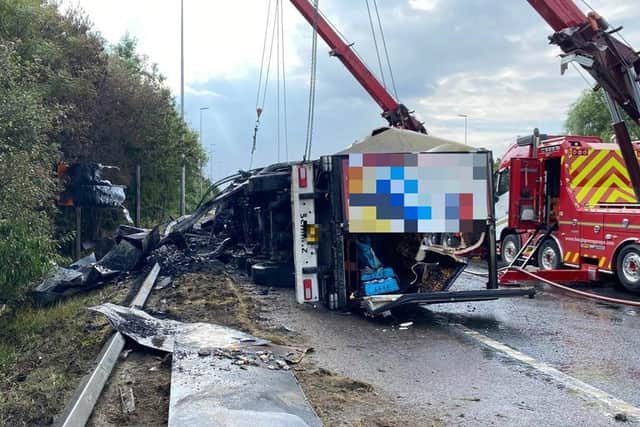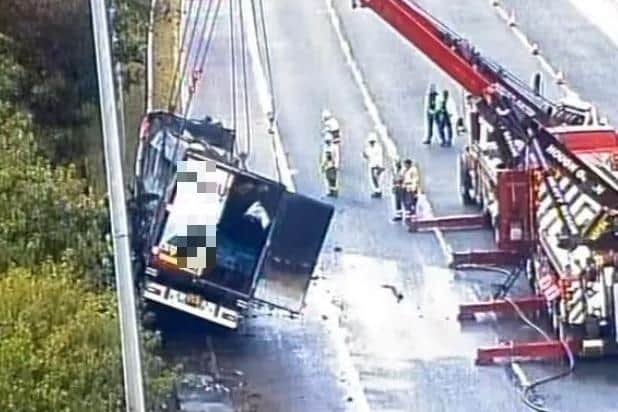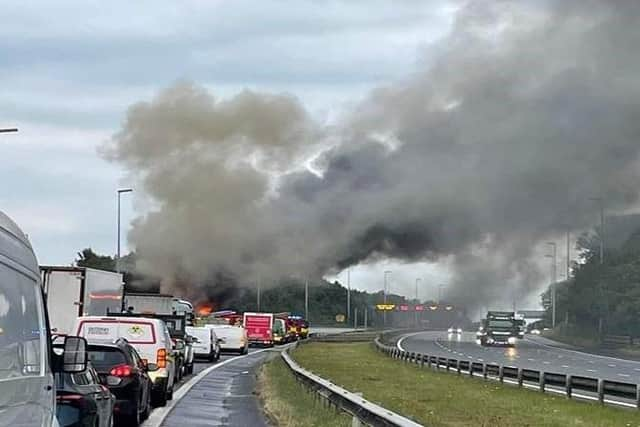M6 closure: This is why it took 22 hours for the motorway to fully reopen following a lorry fire near Preston and what the complex recovery operation involved
and live on Freeview channel 276
Traffic came to a standstill on the motorways surrounding Preston after the lorry caught fire on the southbound carriageway between junctions 32 and 31 at around 6am on Friday (July 29).
Why did the lorry catch fire?
National Highways said it appeared the lorry caught fire after it strayed across several lanes of traffic, struck a bridge parapet and several sections of barrier before coming to a rest.
Was the driver injured?
Advertisement
Hide AdAdvertisement
Hide AdPolice said the lorry driver escaped unscathed and no injuries had been reported.
What happened after the lorry caught fire?
Firefighters rushed to the scene as traffic officers helped drivers trapped between junction 32 and the fire get past the incident safely in lane four.


Trapped traffic was released by 8am.
Information was also displayed on electronic motorway signs to warn oncoming motorists, with the first Tweet sent out at 6.20am to help drivers re-plan their journeys.
Traffic officers remained at the scene throughout the incident helping to manage traffic as well as setting up diversion routes on the A5 and A59.
What was the lorry carrying?


The lorry was carrying frozen chickens.
Why did this hinder the clean-up operation?
Advertisement
Hide AdAdvertisement
Hide AdAs the chickens cooked and burned in the fire, fat seeped across all four lanes of the carriageway, as well as engine oil.
This had to be specially treated and then removed before repairs could begin.


Hundreds of chicken carcasses also had to be removed.
Why is it important oil spills are treated before lanes are reopened to traffic?
It is vital oil spills are treated before lanes reopen to prevent other vehicles from skidding.
Treating spills requires specialist absorbent granules and sometimes sand to be placed over the spillage to soak up the liquid.
Advertisement
Hide AdAdvertisement
Hide AdIt is then left to absorb the spillage before a road sweeper drives along the affected section of road to clear up the material.
Traffic officers then re-examine the surface to assess its skid resistance.
It might take many bags of absorbent material and several applications depending on the extent of the spill.
Why was there so much congestion?
National Highways said congestion on the diversion routes was “unavoidable” as traffic on both the M6 southbound and M55 eastbound relied on it.
Temporary traffic lights along the A59 just west of the M6 at junction 31 also resulted in further delays.
Advertisement
Hide AdAdvertisement
Hide AdA second police-led incident in the afternoon also halted traffic on the northbound and southbound carriageways between junctions 33 and 32, resulting in further congestion.
When did repairs begin?
National Highways was able to get to the scene by about 3pm after the fire service completed their work and the badly damaged lorry was removed.
It was important to make sure the lorry was cool to ensure the fire did not reignite.
Traffic officers cleared the carriageway, repaired or replaced around 200m of barrier and made the bridge safe with the placement of a temporary system on the hard shoulder.
Carriageway damage was fortunately confined to the hard shoulder.
Officers also had to clean up engine oil and animal fat.
When did the carriageway reopen?
Advertisement
Hide AdAdvertisement
Hide AdThe M65 eastbound and one lane on the M6 southbound reopened at around 11pm, with two lanes open by 4pm and three by 8pm.
One lane remained closed overnight for barrier repairs, reopening at approximately 4.20am on Saturday (July 30).
